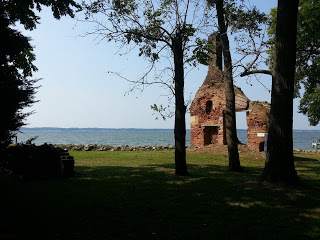Since I was a little boy I had heard stories about the old home place of my grandmother's family. It had a name — perhaps Four Chimneys, or maybe it was Two Chimneys — but most folks in my family called it Towles Point, not far from where the broad Rappahannock opened onto the Chesapeake Bay. It had been the place where my great-grandmother, Margaret Delaney Towles, had been born in 1844 and where my grandmother, Mary Atkinson Monie Betts, had perhaps visited her grandparents sometime during her 103-year lifetime since her birth in 1876. It had been, according to to an aging volume called Virginia Homes and Churches, "not only one of the oldest houses in Virginia, but is remarkable for having continued for more than two hundred years in the possession of one family."
It was built in 1712 by Henry Towles, and it was occupied until 1933, when my grandmother would have been 57. Sometime after that the house fell into disrepair, and eventually collapsed. The old ornamental iron gateway disappeared into someone's possession, and the property became overgrown and tangled with the encroaching forest. My cousin Sid Paine and his brother Christopher had both visited the site decades ago and found a brick and a nail; they recalled there was little left of the place other than a chimney. Martha B. and I had visited nearby in the 1990s and thought we had gotten to the right site, but all we could see was a jungle there on the banks of Towles Point, just inside Day Beacon 6 a few hundred yards out into the channel.
Then in June, while we were anchored on a sailing vessel with friends across the Rappahannock near Urbanna, I happened to notice on a nautical chart these words: "Towles Point — submerged ruins" — just about three miles east. That fired my imagination and made me want to look again. Maybe the foundation of the old house was underwater, or at least partially so. So when my cousin Sid and his wife Elaine invited us to visit them in a time share at Williamsburg's Powhatan Resort last week, we agreed to make another visit. Towles Point appeared to be about a two-hour drive, give or take a dozen or so stoplights and stop signs, from Williamsburg.
The ruins were not where we thought they were, but they were right where they had been since the house was built 301 years ago. Someone had bought the place, cleared the undergrowth, built a new house and garage nearby and, apparently, lovingly preserved the ruins, if that's the right phrase, to protect them for years ahead — capping raggedy parts of the brick and mortar with new concrete, repointing some of the mortar and, I suspect, putting in one new mantle beam to help support what was left. The remaining ruins are well above the waterline and much of the northwest wall, with one standing chimney and at least three fireplaces, showing.
A placard on the bricks reads: "Towles Point Plantation. Towles Family Home. Occupied 1712-1933." The place now belongs to a family from Richmond, according to records at the Lancaster County Courthouse. I'm glad it's in their hands. It is certainly better kept than we could have managed, and it still stands, at least in part, on a point of land in a region that has seen momentous events in American history occur on its waters and in its fields and forests. It remains a familiar landmark for the living and for the ghosts of the dead who first settled these parts more than three centuries ago.









